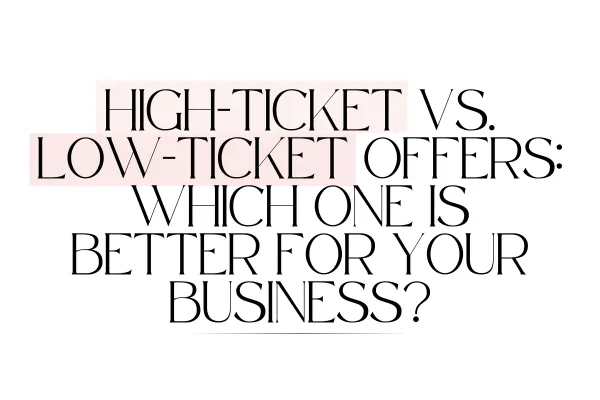
High-Ticket vs. Low-Ticket Offers: Which One is Better for Your Business?
High-Ticket vs. Low-Ticket Offers: Which One is Better for Your Business?
Are you wondering how to make more money with your business?
Choosing the right products to sell can make a BIG difference!
Let’s dive into high-ticket and low-ticket offers to see which strategy aligns best with your goals.
1. What Are High-Ticket and Low-Ticket Offers?
High-Ticket Offers:
High-ticket offers are very expensive products or services. They can cost hundreds or even thousands of dollars. These items are special because they give a lot of value and are often customized for the purchaser. Think of luxury services, private lessons, or exclusive club memberships.
Low-Ticket Offers:
Low-ticket offers are much cheaper, usually costing less than $100. These are easier for more people to buy and can sell a lot. Examples include e-books, simple online courses, or jam-packed bundles.
2. Why Every Business Needs a Low-Ticket Offer
Accessibility and Customer Acquisition:
Low-ticket offers make it easy for new customers to experience your teaching style, methods, and unique wisdom without committing to your hick-ticket offer. They also help build trust and loyalty.
Building a Customer Base and Fostering Loyalty:
After buying something small, customers are more likely to return for bigger, pricier items. Once they see the value in your low-ticket offer, they’ll trust you more and be willing to invest in your high-ticket products or services, knowing they’ll receive high quality and valuable results.
Upselling and Cross-Selling Opportunities:
A low-ticket item can lead to bigger sales later. For example, a customer who buys an e-book might later pay for a premium coaching program. Once they see the value in the e-book, they will be more confident in your expertise and more willing to invest in higher-priced offerings, knowing they will receive substantial benefits and personalized support.
Examples of Successful Low-Ticket Offers:
Templates
Video training
E-book
Checklist
Trackers
30 Day Challenges
3. Which One Should You Choose?
Choosing between high-ticket and low-ticket offers depends on what your business needs and what your customers want.
When High-Ticket is Better:
If you have a special market that wants premium stuff.
If your product needs customization.
If you want to be seen as a luxury brand.
When Low-Ticket is Better:
If you want lots of customers fast.
If you want new people to try your brand.
If your product can be sold easily and in large numbers.
Hybrid Approach:
Many businesses use both high-ticket and low-ticket offers simultaneously. This way, they can reach different types of customers. By offering a range of products and services at varying price points, you can attract a broader audience. Low-ticket items can draw in new customers and build trust, while high-ticket offers can maximize profits from those looking for premium value. This strategy allows you to cater to diverse needs, encouraging initial purchases with affordable options and then guiding satisfied customers toward more expensive, comprehensive solutions.
4. Pros and Cons of High-Ticket and Low-Ticket Offers
High-Ticket Offers:
Pros: High profit, fewer sales needed to reach goals, premium feel.
Cons: Harder to sell, longer sales process, needs more trust to purchase.
Low-Ticket Offers:
Pros: Easier to sell, more people are able to purchase, quick sales process.
Cons: Lower profit, needs more sales to reach goals, can seem less valuable.
Conclusion
Knowing the different strategies between high-ticket and low-ticket offers can help your business grow. Low-ticket offers attract new customers and create upselling opportunities.
Action Step:
Look at what you offer now. Think about how you can add both high-ticket and low-ticket offers.
Oh, and btw - whenever you’re ready to take the next step, I’m here for you.
Here are a few other ways we can work together:
150 Call to Actions that REALLY work! - GRAB THEM HERE
77 Business Ideas to Start in 2024 - GRAB THEM HERE
101 Attention-Grabbing Hooks - GRAB THEM HERE
WORK WITH ME: Business Owners who are ready to turn up the volume on their social media without lifting an extra finger - START HERE
